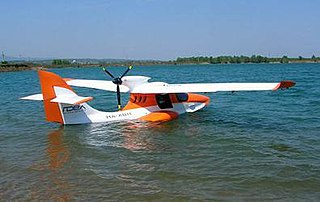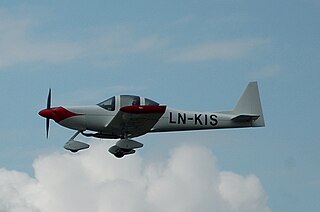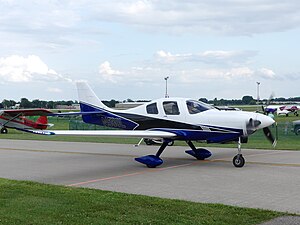
The Piper PA-28 Cherokee is a family of two-seat or four-seat light aircraft built by Piper Aircraft and designed for flight training, air taxi and personal use. The PA-28 family of aircraft comprises all-metal, unpressurized, single piston-engined airplanes with low-mounted wings and tricycle landing gear. They have a single door on the right side, which is entered by stepping on the wing.

The ADI Stallion is a US civil utility aircraft that first flew in July 1994. It is marketed in kit form for homebuilding by Aircraft Designs Inc.

The Cessna 400, marketed as the Cessna TTx, is a single-engine, fixed-gear, low-wing general aviation aircraft built from composite materials by Cessna Aircraft. The Cessna 400 was originally built by Columbia Aircraft as the Columbia 400 until December 2007. From 2013, the aircraft was built as the Cessna TTx Model T240.

The Cessna 210 Centurion is a six-seat, high-performance, retractable-gear, single-engined, high-wing general-aviation light aircraft. First flown in January 1957, it was produced by Cessna until 1986.

The Cessna 414 is an American light, pressurized, twin-engine transport aircraft built by Cessna. It first flew in 1968 and an improved variant was introduced from 1978 as the 414A Chancellor.

The Lancair IV and IV-P are a family of four-seat, low-wing, retractable-gear, composite monoplanes powered by a 550-cubic-inch (9,000 cm3) Continental TSIO-550 twin-turbocharged piston engine.

The Progressive Aerodyne SeaRey is an American two-seat, single-engine, amphibious flying boat designed and manufactured by Progressive Aerodyne originally in Orlando, Florida, and now in Tavares, Florida. It was first flown in November 1992 and is sold as a kit aircraft for amateur construction as well as a light-sport aircraft.

The Lancair Legacy, a modernized version of the Lancair 320, is a low-wing two-place retractable-gear composite monoplane manufactured by the American company Lancair. It is available as a kit that cost US$71,500 in 2011. There is also a fixed-gear version, the Legacy FG. The retractable version of the Legacy cruises at 276 mph at 8,000 ft and the fixed gear version cruises at 215 mph.

The Lancair 360 is a two-seat aircraft marketed in kit form. It is a low-wing monoplane of conventional configuration with retractable tricycle undercarriage. The Lancair Legacy was chosen to replace the Lancair 360 in 1999.

The Sling Aircraft Sling 2, formerly called The Airplane Factory Sling 2, is a South African two-seater light aircraft designed and produced by Sling Aircraft in Johannesburg, South Africa. In 2009 the specially modified second prototype was flown around the world in a westerly circumnavigation which took 40 days. This was the first time any aircraft of this class had achieved a circumnavigation. The design complies with the requirements of four different regulatory aircraft classes.

The Idea Hydropteron is a Hungarian light-sport aircraft and kit aircraft amphibious flying boat, under development by Idea Aircraft, of Miskolc. The Hydropteron was first flown on 25 November 2009 and introduced to the public at the AERO Friedrichshafen show in 2010. The aircraft is intended to be supplied as a kit for amateur construction or as a complete ready-to-fly-aircraft.

The Polen Special, is a homebuilt racing aircraft built to become the fastest four cylinder aircraft in the world.
The RMT Bateleur is a German ultralight and light-sport aircraft, designed by Andre von Schoenebeck and produced by RMT Aviation of Bad Bocklet. The aircraft is supplied as a kit for amateur construction or as a complete ready-to-fly-aircraft.

The Tri-R KIS TR-1 is an American homebuilt aircraft that was designed by Rich Trickel and produced by Tri-R Technologies of Oxnard, California, introduced in the 1990s. When it was available the aircraft was supplied as a kit for amateur construction.

The Swiss Excellence Risen is a Swiss two-seat in side-by-side configuration, low wing ultralight aircraft, designed by Italian-Argentine aeronautical engineer Alberto Porto and produced by Swiss Excellence Airplanes. The aircraft was introduced at the 2015 AERO Friedrichshafen show. It is supplied ready-to-fly.
The Wega 180 is a Brazilian amateur-built aircraft designed and produced by Wega Aircraft of Palhoça, Santa Catarina, introduced at the Sun 'n Fun airshow in 2013. The aircraft is supplied as a kit for amateur construction or as a complete ready-to-fly-aircraft.
The Lancair Barracuda is an American amateur-built aircraft produced by Lancair of Uvalde, Texas. It was introduced at AirVenture in July 2018. The aircraft is supplied as a kit for amateur construction.
The Lancair Sentry is an American amateur-built aircraft that was designed and produced by Lancair of Redmond, Oregon, introduced in 2002. The aircraft was supplied as a kit for amateur construction, although it was also intended as a production military trainer aircraft. First flown in September 2001, only two were ever completed.

The Lancair 200 and Lancair 235 are a family of American amateur-built aircraft that were designed by Lance Neibauer and produced by his company, Lancair of Redmond, Oregon. The Lancair 200 was initially called the Lancer 200, but the name was changed due to a naming conflict. It was first shown at AirVenture in Oshkosh, Wisconsin in July 1985. Now out of production, when it was available the aircraft was supplied as a kit, for amateur construction.

The Tecnam P-Mentor is an Italian light aircraft, intended for flight training, designed and produced by Tecnam of Casoria. It was introduced in April 2022 and is EASA CS-23 type certified in Europe.

















